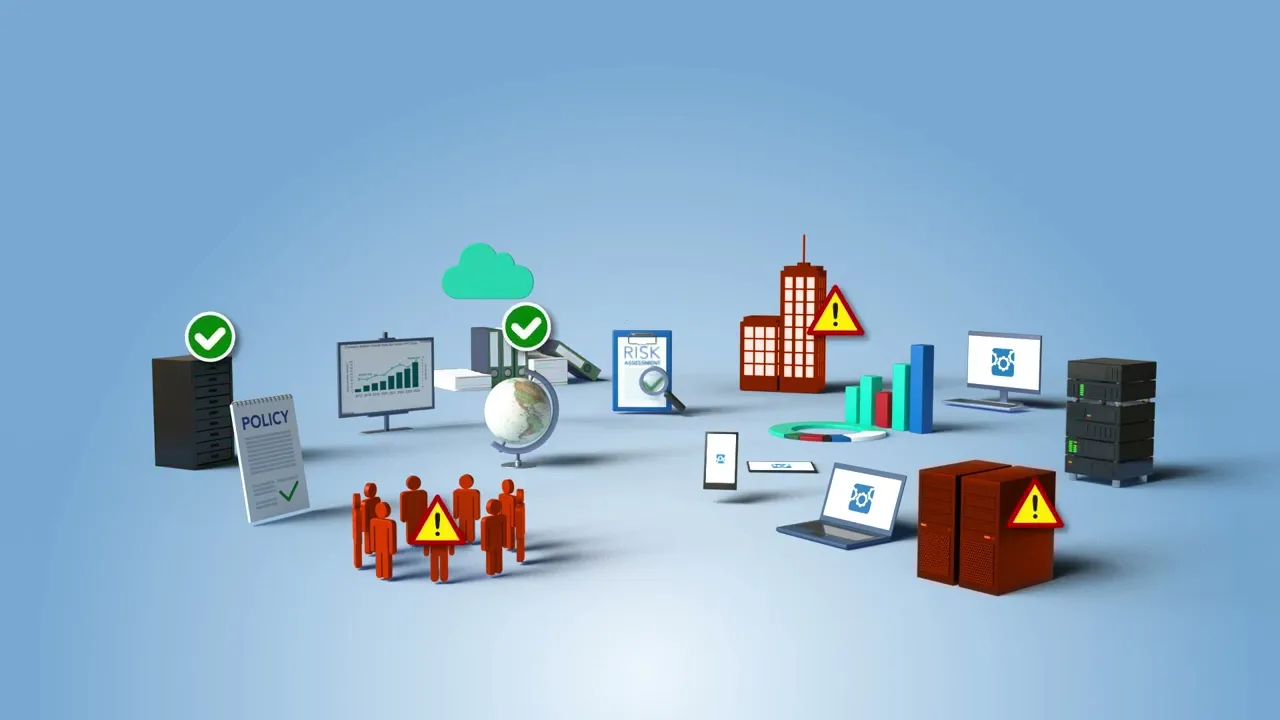Your Roadmap to Risk Reduction!
Table of Contents
ToggleThe Continuum GRC ITAM SaaS platform has hundreds of plugin modules available, such as:

FDA 21 CRF 11 & Annex 11
Title 21 CFR Part 11 is the portion of the Code of Federal Regulations that provides standards determined by the Food and Drug Administration (FDA) on electronic records and electronic signatures. With electronic records widely used in the Life Sciences industry, most companies will find FDA 21 CFR Part 11 applicable.
Regulated companies with documents or records in electronic format must comply with FDA 21 CFR part 11. Part 11 pertains to pharmaceutical companies, manufacturers of medical devices, biotechnology companies, CROs, biologics developers, and other companies regulated by the FDA.
Part 11 helps companies safely maintain data securely so that it is not lost or corrupted, ensures companies are implementing systems and software correctly, makes sure there are data-trace changes and prevents falsified records.
Modules include:
- Impact of 21 CFR Part 11 on the organization's computer systems, including Quality Management Systems
- Identification of the organization's computer systems and operating environment
- Hosting and interpretation of user interviews
- Review and consideration of organizational procedures
- Analysis of procedural documentation, validation, and audit data
- Regulatory significance of the computer systems
- Annex 11 for European Union compliance
FDA 21 CFR Part 11 Compliance Solutions
Compliance with these particular requirements is designed to ensure that electronic records and electronic signatures used meet FDA standards for reliability, validity, and security. They include document management systems, solutions to ensure that electronic signatures are as secure and valid as paper records, audit trails, and automated record keeping, and of course, data security measures like encryption.
Part 11 is about streamlining the process of electronic record-keeping for improved automation, efficiency, and security. It defines the criteria and standards needed for the storage, access, and transmission of electronic records.
Why Choose Us
Continuum GRC offers all of the resources, guidance, and solutions required to be in compliance with FDA 21 CFR Part 11. We have the deep experience to do a thorough assessment of your current practices and bring them up to speed. Because this certification is primarily electronic records-related, we’ll do a deep dive into your processes and infrastructure and recommend improvements to make them more efficient and secure.
Our IT risk management solutions are used and trusted by the world’s leading companies. We understand the complexities involved in governance structures and requirements. Continuum GRC oversees each step of the process to simplify implementation.
FAQ
What is FDA 21 CFR Part 11 compliance?
This is designed to ensure that electronic records and electronic signatures used by industries regulated by the FDA (like medical device companies) are trustworthy, and equal to handwritten records. Electronic data must be verified, maintained, and stored in ways that ensure authenticity, confidentiality, and integrity.
What is the difference between 21 CFR Part 11 and Annex 11?
These guidelines are both focused on electronic records and signatures and how they’re handled. 21 CFR Part 11 governs electronic records and signatures around FDA activities like clinical trials and manufacturing.
Annex 11 are similar guidelines established by EU’s Good Manufacturing Practice (GMP), focused on broader computerized systems used in GMP-related activities.
Does my system need to be 21 CFR Part 11 compliant?
If your system is used to create, maintain, modify, or transmit records linked to FDA regulation, then, yes - your system needs to be compliant with these requirements. Also, if your system handles any kind of data used in FDA activities or regulated by the FDA, it needs to meet these compliance standards.
What is an FDA 21 CFR Part 11 compliant system?
It’s a computerized system following the regulations laid out by 21 Part 11 in the Code of Federal Regulations, specifically related to electronic records and signatures. The system should ensure the accuracy, consistency, and reliability of these respective electronic components as if they were the equivalent of paper records.
Can FDA 21 CFR Part 11 compliance be achieved without paper records?
Part 11 is designed to allow electronic records and signatures to be used in place of paper records. The requirements are meant to ensure that these electronic components are as trustworthy and reliable as paper documents. Part 11-compliant technology helps the organization reduce reliance on paper records.
What is the role of risk management in FDA 21 CFRPart 11 compliance?
Risk management processes include assessing potential risks to electronic data integrity, discrepancies between Part 11 requirements, and remediation plans around any vulnerabilities. It streamlines the process of pinpointing compliance issues and fixing them. Continuum GRC knows exactly what to look for and how to make remediation simpler.
What are you waiting for?
You are just a conversation away from putting the power of Continuum GRC to work for you.
Contact us using the form below or calling us at 1-888-896-6207 for immediate assistance.
About this standard
FDA 21 CFR Part 11, titled "Electronic Records; Electronic Signatures," is a regulation established by the U.S. Food and Drug Administration (FDA) that sets standards for electronic records and electronic signatures to ensure their reliability, integrity, and equivalence to paper records. It applies to organizations in FDA-regulated industries, such as pharmaceuticals, biotechnology, medical devices, and food, that use electronic systems to create, modify, maintain, or transmit records required by FDA regulations.
Below is a concise compliance overview of 21 CFR Part 11, covering its key requirements and considerations:
Scope and Applicability
- Purpose: Ensures electronic records and signatures are trustworthy, reliable, and equivalent to paper-based records and handwritten signatures.
- Applicability: Applies to electronic records and signatures used to meet FDA predicate rules (e.g., Good Manufacturing Practices, Good Clinical Practices) when maintained or submitted electronically.
- Covered Records: Includes records created, modified, archived, retrieved, or transmitted under FDA regulations, such as manufacturing batch records, clinical trial data, and quality control documentation.
Key Requirements
21 CFR Part 11 is divided into three main subparts: General Provisions, Electronic Records, and Electronic Signatures.
1. General Provisions (Subpart A)
- Definitions: Defines terms like electronic record (any digital data) and electronic signature (digital representation of a person’s intent, e.g., username/password or biometric).
- Implementation: Systems must comply if they are used for FDA-regulated activities involving electronic records or signatures.
- Exemptions: Paper records with handwritten signatures are not subject to Part 11, but hybrid systems (paper and electronic) may require compliance for the electronic components.
2. Electronic Records (Subpart B)
- System Validation: Electronic systems must be validated to ensure accuracy, reliability, and consistent performance (Section 11.10(a)).
- Audit Trails: Systems must generate secure, computer-generated, time-stamped audit trails to track changes to records, including who made the change, when, and why (Section 11.10(e)).
- Access Controls: Limit system access to authorized individuals through unique user IDs and passwords or other secure methods (Section 11.10(d)).
- Data Integrity: Ensure records are accurate, complete, and protected from unauthorized changes (Section 11.10(b)).
- Record Retention and Retrieval: Systems must allow for easy retrieval of records throughout their retention period and produce copies in both human-readable and electronic formats (Section 11.10(b), (c)).
- Operational Checks: Enforce proper sequencing of steps and events (e.g., ensuring data is entered in the correct order) (Section 11.10(f)).
- Device Checks: Verify the identity of devices or systems entering data (Section 11.10(h)).
- Training: Personnel using electronic systems must be adequately trained (Section 11.10(i)).
- Written Policies: Establish policies holding individuals accountable for actions under their electronic signatures and to deter falsification (Section 11.10(j)).
- System Documentation: Maintain documentation for system controls and configurations (Section 11.10(k)).
3. Electronic Signatures (Subpart C)
- Uniqueness: Electronic signatures must be unique to individuals and not reused or reassigned (Section 11.100(a)).
- Identity Verification: Organizations must verify the identity of individuals before assigning electronic signatures (Section 11.100(b)).
- Certification: Organizations must certify to the FDA that electronic signatures are equivalent to handwritten signatures before use (Section 11.100(c)).
- Signature Components: Non-biometric signatures require at least two distinct components (e.g., username and password) (Section 11.200(a)).
- Signature Binding: Electronic signatures must be linked to records to prevent alteration or falsification (Section 11.200(a)(3)).
- Controls for Signatures: Ensure signatures are used only by their rightful owners and include safeguards against misuse (Section 11.300).
Key Compliance Considerations
- Risk-Based Approach: The FDA’s 2003 guidance, “Part 11, Electronic Records; Electronic Signatures — Scope and Application,” emphasizes a risk-based approach, focusing on records critical to product safety, quality, and efficacy. Not all electronic records require the same level of controls.
- Predicate Rules: Compliance with Part 11 does not replace compliance with underlying FDA regulations (e.g., 21 CFR Parts 210, 211 for GMPs). Part 11 applies only to electronic systems used to meet those requirements.
- Closed vs. Open Systems:
- Closed Systems: Access is restricted to authorized users within the organization (e.g., internal databases). These require fewer controls (Section 11.10).
- Open Systems: Accessible to external users (e.g., cloud-based systems), requiring additional security measures like encryption (Section 11.30).
- Legacy Systems: Systems implemented before August 20, 1997, may not need full compliance if they meet certain conditions, but upgrades or new uses may trigger Part 11 requirements.
- Vendor Accountability: Organizations are responsible for ensuring third-party systems (e.g., cloud providers, software vendors) comply with Part 11.
Enforcement and Inspections
- FDA Inspections: The FDA audits systems for Part 11 compliance during routine inspections, focusing on validation, audit trails, data integrity, and security.
- Non-Compliance: Violations can result in warning letters, fines, or product recalls. Common issues include inadequate validation, lack of audit trails, or weak access controls.
- Data Integrity Focus: Recent FDA guidance (e.g., “Data Integrity and Compliance with Drug CGMP” from 2018) emphasizes protecting data from manipulation or falsification.
Practical Steps for Compliance
- Gap Analysis: Assess current systems against Part 11 requirements to identify gaps.
- System Validation: Develop and execute validation protocols for all electronic systems.
- SOPs: Create standard operating procedures for system use, access control, and audit trail management.
- Training Programs: Train staff on Part 11 requirements and proper system use.
- Audit Trails and Security: Implement robust audit trails and access controls to protect data integrity.
- Vendor Management: Ensure third-party vendors provide Part 11-compliant systems and documentation.
- Regular Audits: Conduct internal audits to maintain compliance and prepare for FDA inspections.
Recent Trends and Updates
- Cloud and Emerging Technologies: The FDA has increased focus on cloud-based systems and software-as-a-service (SaaS) platforms, requiring robust security and vendor oversight.
- Global Harmonization: Part 11 aligns with international standards like EU Annex 11 (Computerised Systems), which has similar requirements for electronic records in the EU.
- Guidance Updates: The FDA continues to issue guidance to address evolving technologies, such as artificial intelligence and blockchain, though no major revisions to Part 11 have been made as of August 2025.
Resources
- Primary Regulation: 21 CFR Part 11 (available on the FDA’s website or eCFR).
- FDA Guidance: “Part 11, Electronic Records; Electronic Signatures — Scope and Application” (2003).
- Related Guidance: “Data Integrity and Compliance with Drug CGMP” (2018).
- Industry Standards: ISPE GAMP 5 (Good Automated Manufacturing Practice) for system validation.

